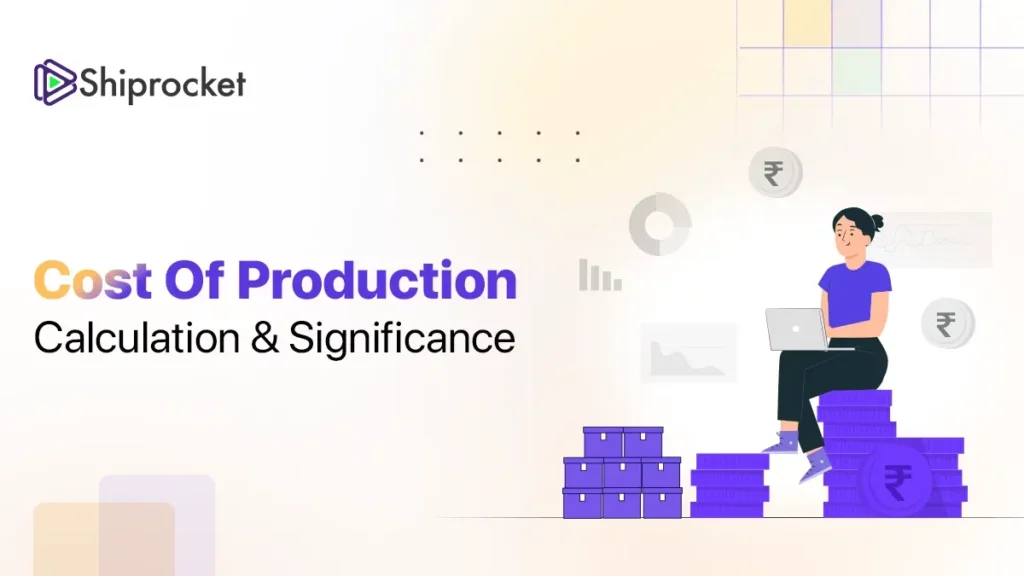Production cost involves all the costs that a business incurs during the manufacturing of a product or while offering a service. It is important to calculate the cost of production of different products and services being offered by a business and compare them with the profit they fetch. This helps determine whether a business owner should continue with its offering or make changes to boost profit.
In this blog, we have covered the various types of cost of production, its significance, method of calculation and more. Read on to find out!

The Concept of Cost of Production
A company is required to bear different kinds of expenses while manufacturing products. These include direct and indirect expenses, variable, fixed and overhead expenses to name a few. All these costs add up to determine the cost of production. The expense incurred while providing a service is also categorised as its production cost. The tax levied by the government also forms a part of the manufacturing cost.
Examples of Cost of Production
Let us understand the concept better with the help of a few examples.
For instance, there is a company that manufactures tables. It requires raw materials such as different kinds of wood, metal components such as screws, nuts, brackets and frames, adhesives, varnish, paint and toughened glass. It also requires skilled labour for the production process. In addition to spending a substantial amount for procuring raw materials and hiring workers, it will also have to bear overhead charges such as electricity bills, factory rentals, maintenance costs, taxes, machinery costs, administrative expenses and insurance premiums. All this adds up to determine the cost of production.
Likewise, suppose there is a pharmaceutical company that manufactures different kinds of medicines. It would require raw materials such as chemical compounds, preservatives, flavourings, solvents, bottles, cartons and blister packs. To carry out the production process, it requires machine operators, technicians, QA analysts and lab technicians. The business will also incur overhead costs such as the rent of the facility, utility bills, taxes, machinery and equipment costs, maintenance charges and administrative expenses. On adding all these costs, you will get the total cost of production.
Categories of Production Costs
Let us take a look at the different categories in which production costs have been categorised:
- Fixed Cost
This is the cost that does not change month on month. It remains fixed and a business has to bear it irrespective of the amount of goods being produced. You cannot cut down on it even if you choose not to manufacture a product during a given period. Some examples of fixed costs are the rent for the facility, utility bills, insurance, loan instalments, employee salaries and insurance premiums. Thus, a business owner has a fair idea about this expense beforehand.
- Variable Cost
Variable cost includes the cost incurred to purchase raw materials and production supplies, packaging rates and delivery charges among other expenses. It fluctuates mainly depending on the number of products manufactured in a given month. In case the demand for a product rises, its production cost also goes up as there is a greater requirement for raw materials, packaging and other things. Likewise, if the demand for a product goes down, then it leads to lower production costs. It is hard to forecast variable costs accurately.
- Direct Costs
These are the expenditures that are directly linked to your product’s manufacturing process. They may be fixed or variable. Some of the examples of direct costs are the charges for labour, raw material, machinery and fuel.
- Indirect Cost
As the term suggests, this cost is not linked directly to the manufacturing process of a product. This may include the maintenance cost of the machinery, marketing cost, administrative expenses, insurance premium and rent paid for the factory. Just like direct cost, this one can also be fixed as well as variable. Also known as overhead or administrative cost, it is included in the total cost of the finished products.
- Marginal Cost
A company incurs marginal costs when it produces additional goods. This may be due to reasons such as accidental damages or theft. It impacts the variable cost.
Evaluating the Cost of Production
As explained above, the cost of production includes all the direct and indirect expenses incurred by a business during the production process. Thus, to calculate this, you must:
- Start by determining the total cost of the direct material used in the production. This mostly includes raw materials and production supplies.
- Then, determine the cost incurred for hiring direct labour. This means the labour or task force is directly involved in the production process. It includes their salaries, wages or any perks given to them.
- You also need to identify the overhead cost incurred in the production process. This includes the cost that indirectly impacts the manufacturing of your goods.
You shall be able to evaluate the cost of production by adding the above 3.
Formula Used to Determine Production Expenses
To determine the production expense, you must use the following formula:
Production Cost = Direct Labour + Direct Material + Overhead Costs on Manufacturing
Importance of Calculating Cost of Production
Businesses need to calculate the cost of production to operate profitably. It helps identify whether the manufacturing expense is higher or lower in comparison to the profit earned from it. If the profit earned is consistently lower compared to its cost of production, then the business may consider discontinuing the product. Alternatively, it may come up with a similar product that requires less production cost. This step is necessary to ensure the financial health of the business. This also applies to the services provided by a company. If the cost involved in offering a service is greater than the profit earned from it then discontinuing the service is better for the company.
Techniques for Monitoring Production Expenses
It is important to monitor the production expenses to keep a check on them. Here are some techniques to manage this task:
- Start by creating a budget for your production expenses and stick to it.
- Generate and check financial reports regularly to compare total spending against your budget. This will help evaluate the difference and give you a chance to improvise.
- Leverage automation to save time and reduce the scope of errors.
- Track your workers’ performance to assess their productivity and efficiency. This will help identify the scope of improvement. You may arrange necessary training to increase their output.
- Conduct regular audits of the production processes to identify opportunities for cost savings.
What to Do if the Production Cost Exceeds The Product’s Sale Price?
It is often recommended to stop manufacturing a product if its production cost exceeds its sale price consistently. However, what if your item is in demand in the market and you do not wish to pull it down? Well, in such a case you can try the following:
- Try Reducing the Production Cost
At times, there are loopholes at certain stages in the production process that lead to high costs of production. It may be that you aren’t striking a good deal with your suppliers or laying hands at raw material that is comparatively reasonable yet high in quality. Likewise, you may be paying labour charges month on month even though you can employ automation at a one-time charge and save money eventually.
- Increase the Product’s Price
You can also increase the sale price of your product to meet and exceed the production expenses. For this, you may require strengthening your position as a brand.
- Outsource Production Process
Outsourcing the production process can also help in this direction. This will help save on labour charges, direct material costs and various other expenses. Striking a good deal is the key to earning greater profit.
Conclusion
It is essential to calculate the cost of production accurately using the formula shared above. By understanding the production cost and comparing it with the amount earned on selling your products, you shall be able to determine whether you are turning profitable or going into losses. Accordingly, you can take measures to curb losses and increase profitability.





